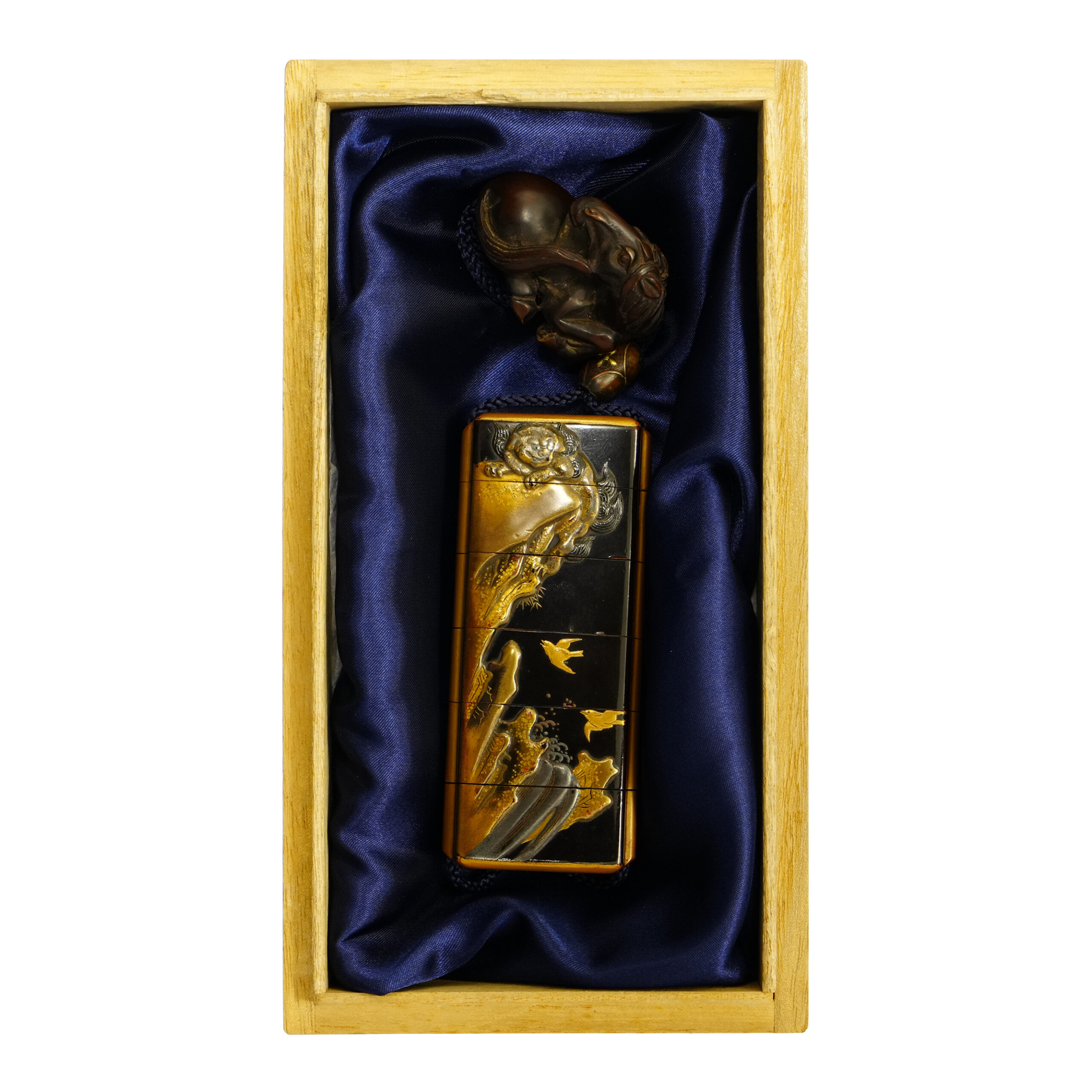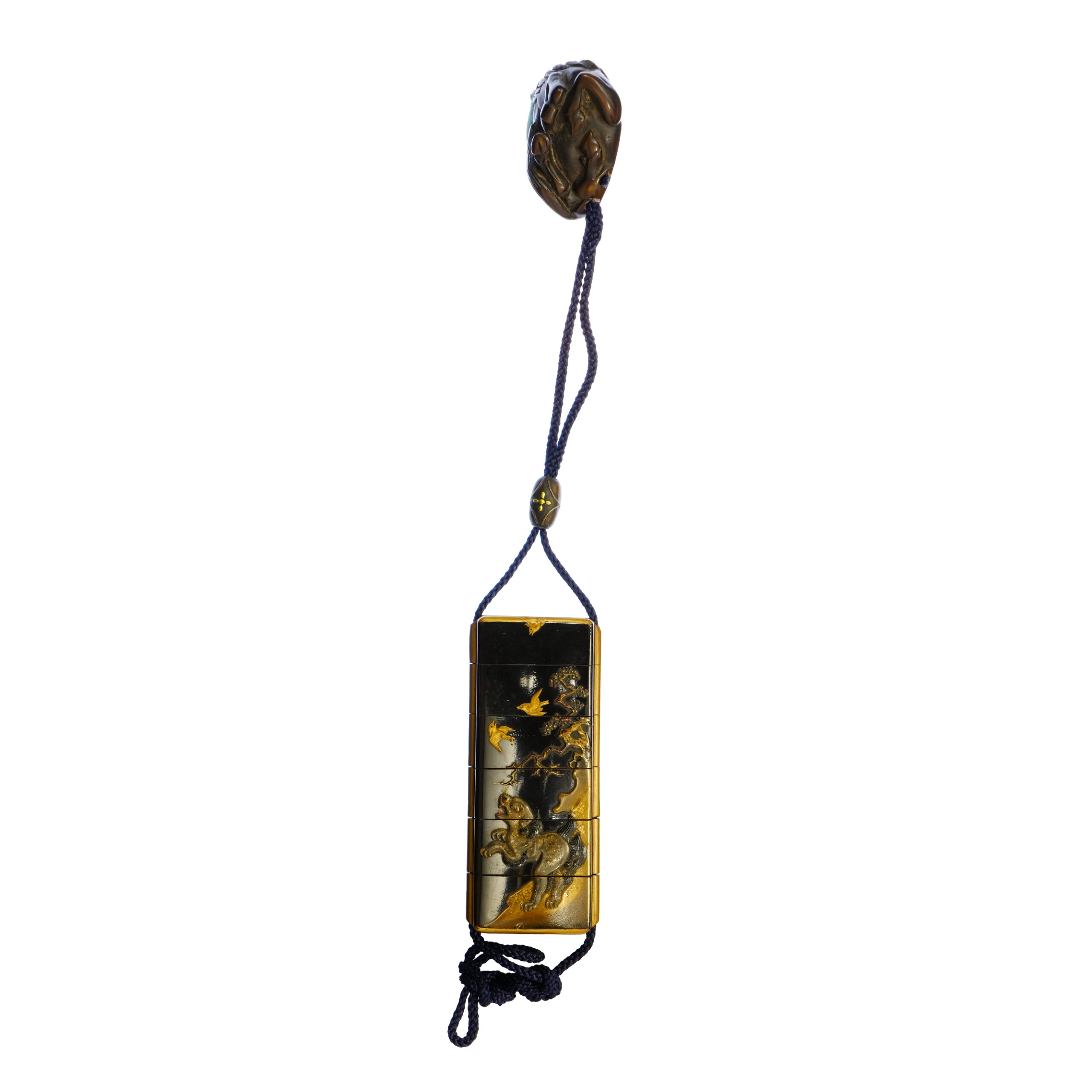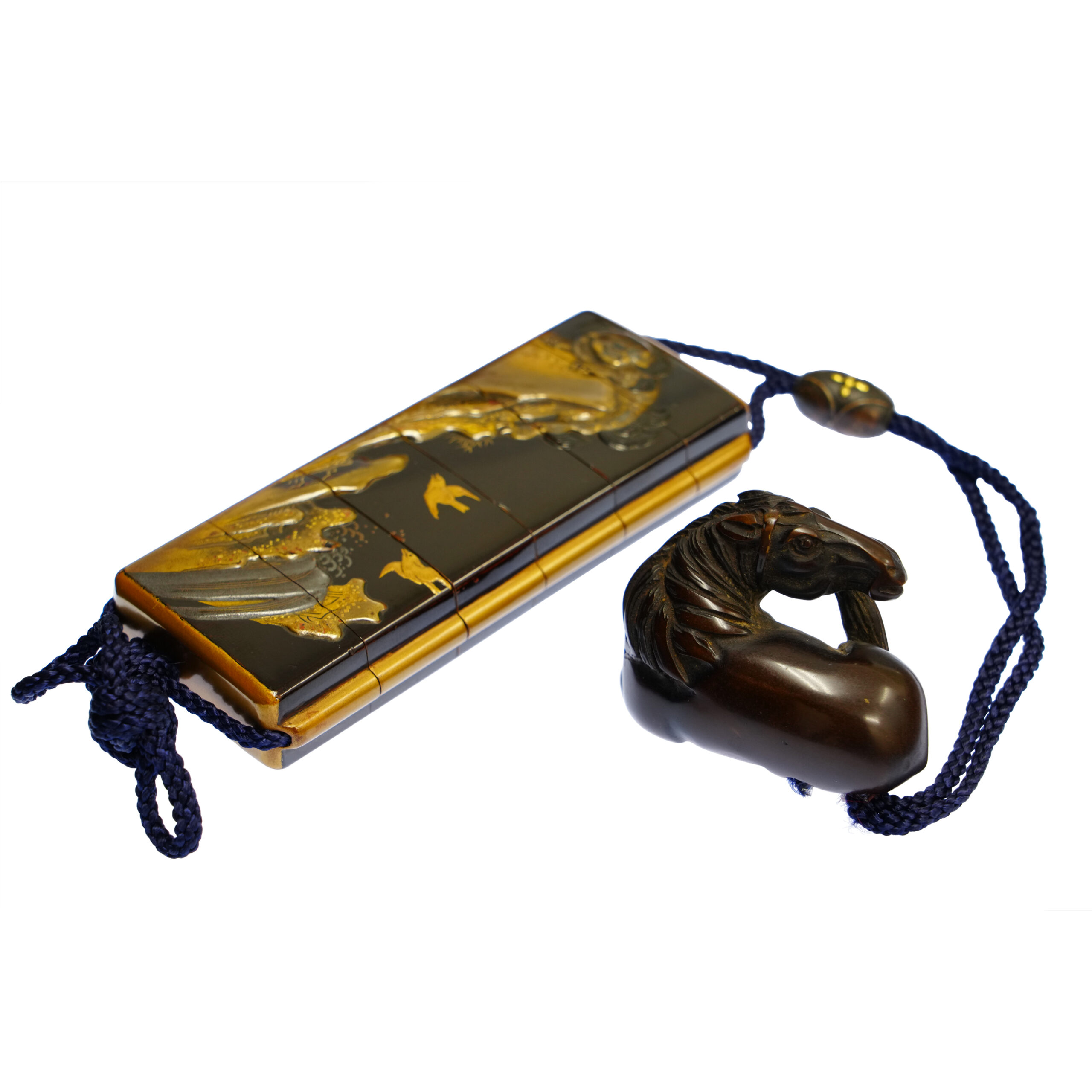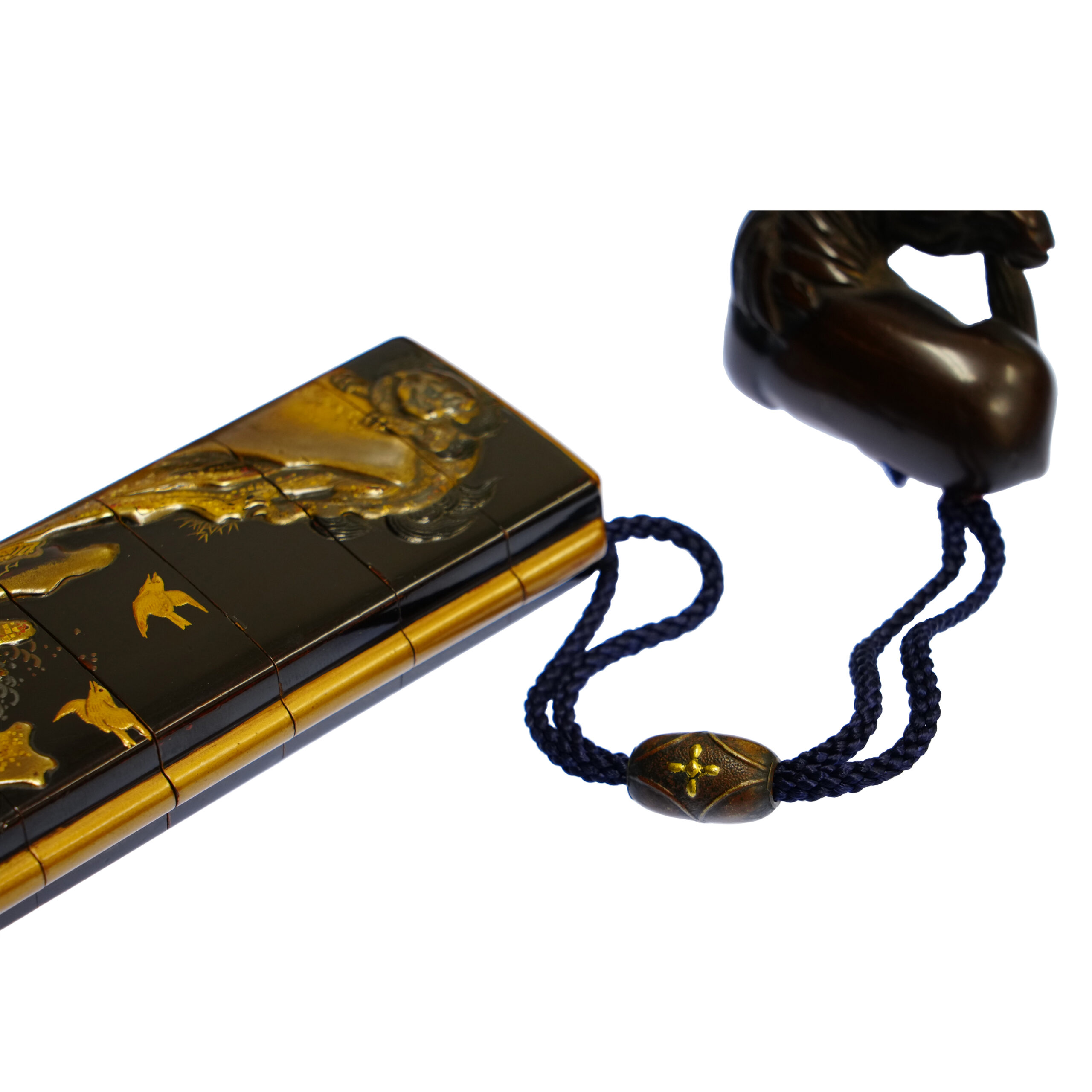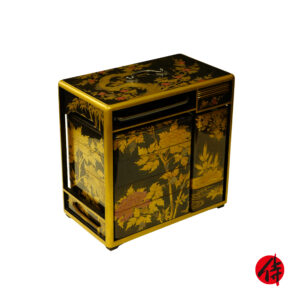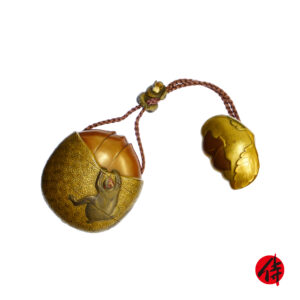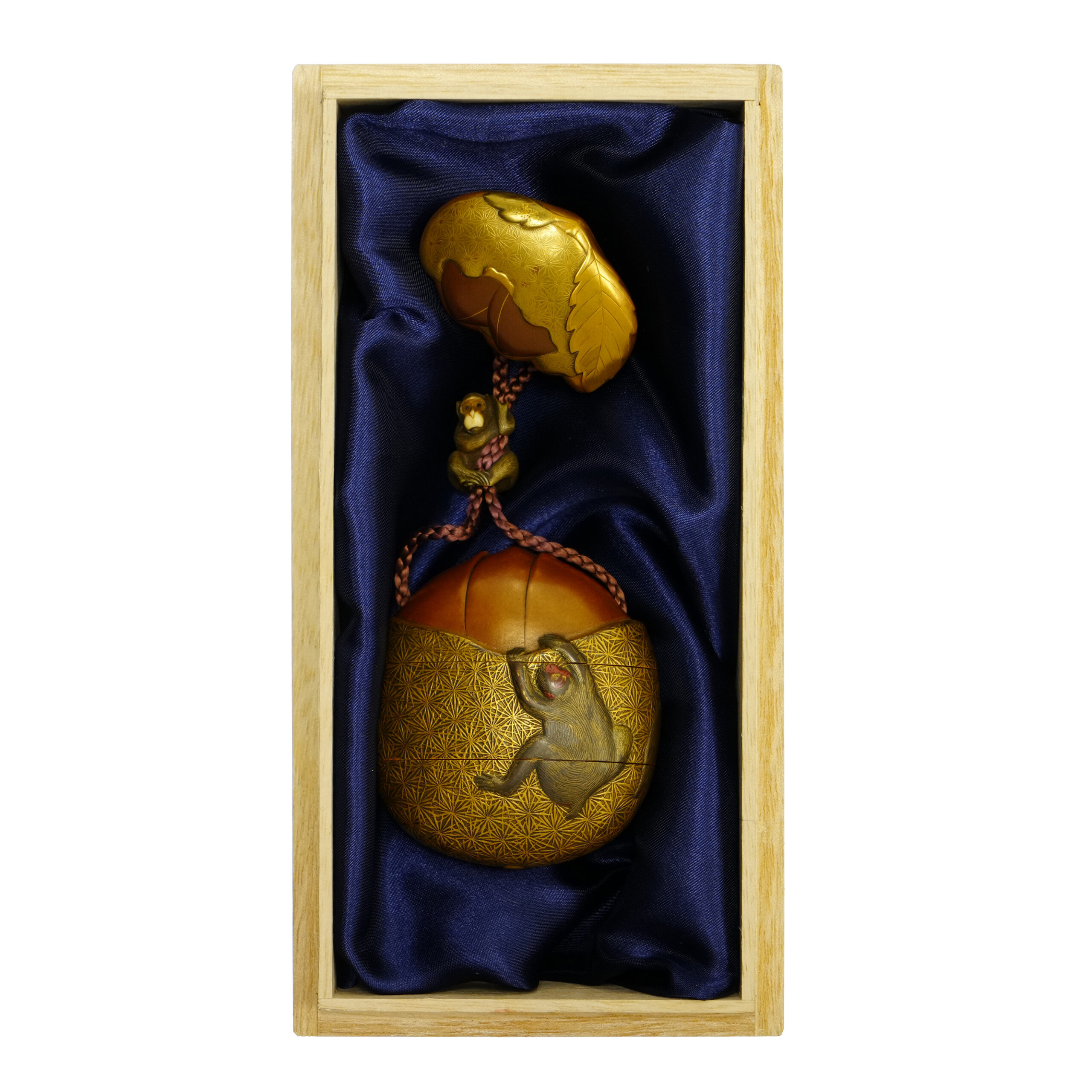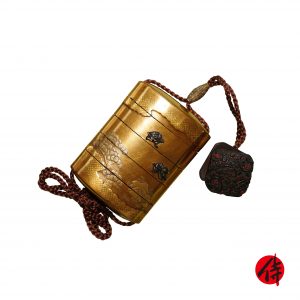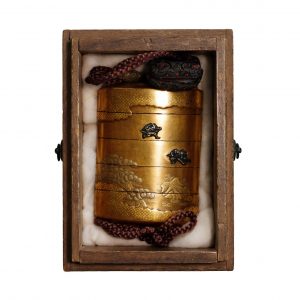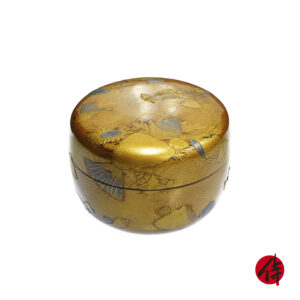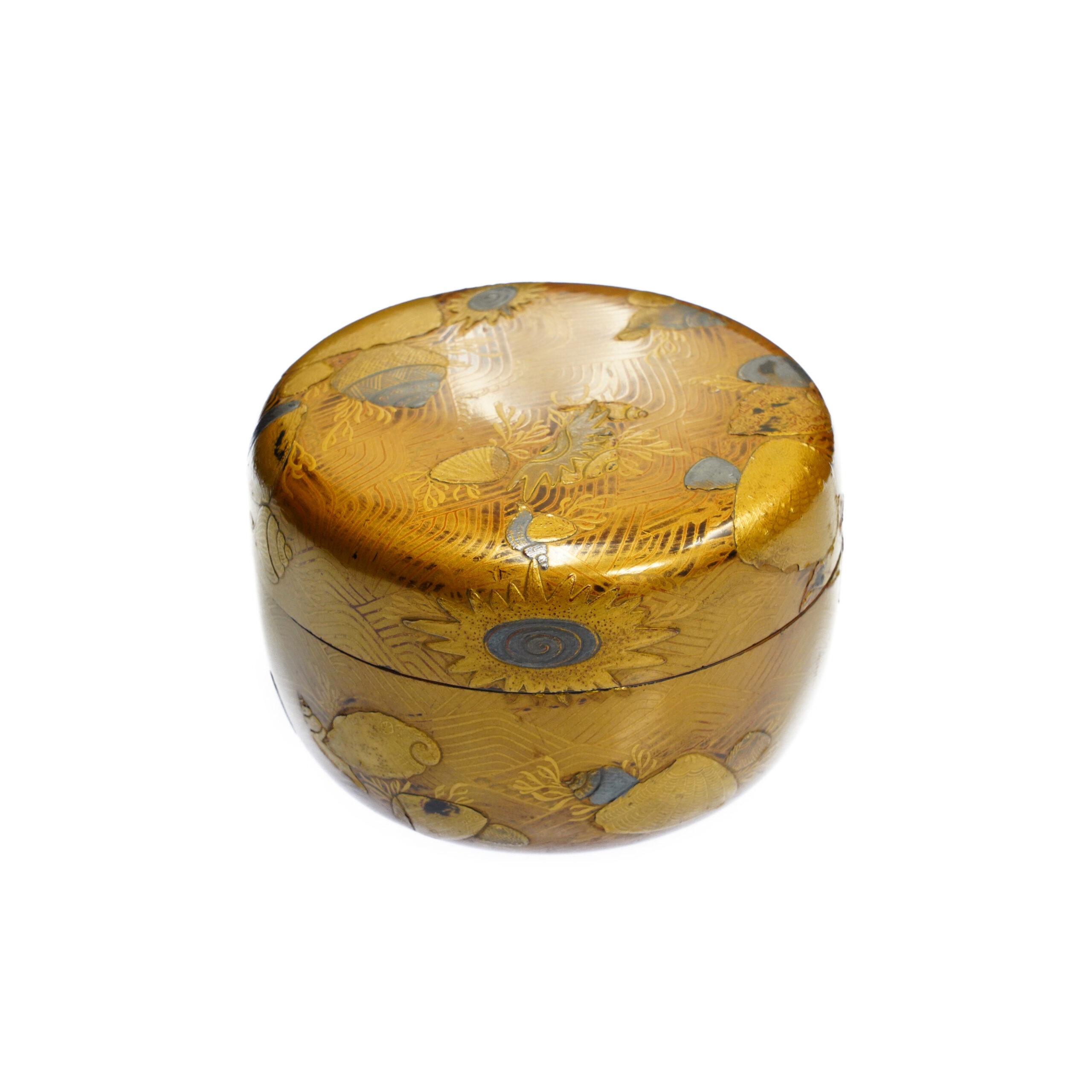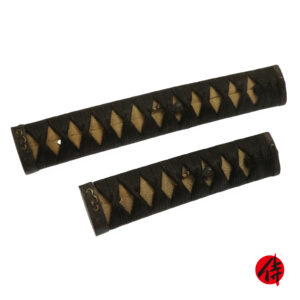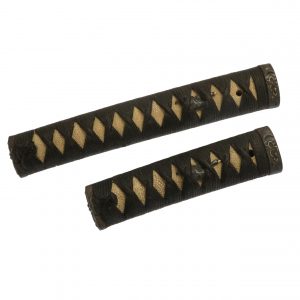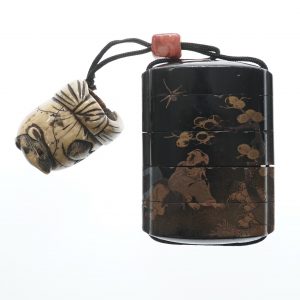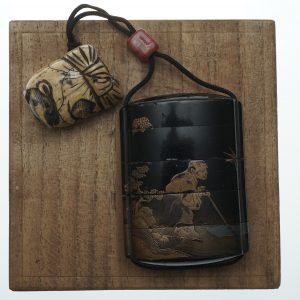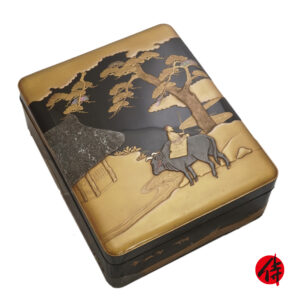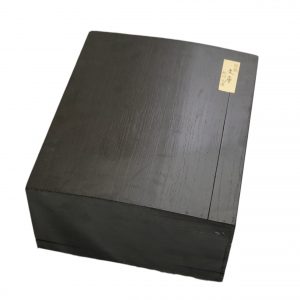Description
This Inro is luxurious, thanks to the Makie (蒔絵) technique. The Makie is a typical Japanese lacquer art technique developed uniquely in Japan for about 1,200 years. Firstly, it needs to draw a picture with lacquer on the surface with a thin brush. Next, sprinkle the gold powder from above to show the pattern before the lacquer hardens. This technique makes a gorgeous and elegant look to works, as seen in this Inro case.
About the design, we believe it is a combination of two auspicious themes. You would find the figures of animals that look similar to lions. These beasts are the Karajishi (唐獅子). The Shishi (獅子) means a lion in Japanese, and the Karajishi is a lion brought from the continent to Japan in the Toh period (唐, Tang dynasty, 618-907). The Karajishi typically has curly hair for its head, neck, body, and tail. A simplified pattern of this curly hair is carved as the body hair pattern of the Karajishi on this Inro. In Buddhism, the Karajishi is regarded as a symbol of wisdom, and Monju Bosatu (文殊菩薩, Manjushri Bodhisattva) rides lions. According to a theory, the Karajishi is the origin of Komainu (狛犬, stone guardian dogs that exorcize evil spirits). It shows this beast motif has been familiar to Japanese people since ancient times.
Other characters depicted on this Inro case, you would also find small birds. And in the background of the birds, you could see a waterfall. This is a classical motif called the Nami Chidori (波千鳥). The Nami (波) means waves, and Chidori (千鳥) is a plover. The Nami Chidori pattern represents a happy marriage and family safety. In Japan, people have treated it as a good omen design since the Nara period (648-781). Waves are compared to the world, which describes determination: overcoming difficulties with a partner even if there are small or big waves (difficulties/ troubles). Also, the plover pattern is used as a prayer. The Japanese name of the plover, Chidori, was associated with the word Chidori (千取り, which literally means get a thousand). Therefore, its design contains prayers for victory and wishes for goal achievement.
The Ojime (緒締, part between the Inro case and the Netsuke) is a component that prevents the Inro case from opening, and it also has another role in combining two strings into one. The motif of this work’s Ojime is a tapered cylindrical shape with a cross-shaped pattern painted in gold. And the Netsuke (根付, miniature sculpture, fastener) is modeled as a horse. Horses have been around human life for a long time, not only as our food but also for transportation or carriage of luggage. In Japan, horses were thought of as vehicles for gods to be dedicated to shrines in ancient times. It is said it is the origin of Ema (絵馬, picture tablet used as an offering at a shrine) today. Horses had been used as a tool for rituals and festivals. After the age of the Samurai warriors appeared, wearing large armor or performing archery and riding a hose became martial arts. Equestrian tactics became the pillar of military action and security activities. According to a theory, that is the reason that the Japanese sword began to have a curve to make it suitable for slashing (the Japanese sword was straight in the beginning). Among the horse patterns, there is a design called the Hidari-Uma (左馬). The letter “馬” means a horse and describes the figure of a horse running to the left. And the Hidari-Uma pattern refers to a picture of a horse running to the right. It shows the turning over of the “horse (Uma).” There is the word Mau (舞う, dancing) in Japanese; people thought happiness would come down in association with “turning the horse” and “dancing.” Also, the horse pattern has been loved as an amulet to pray for prosperity in business.
We hope you enjoyed this description and wish this Inro would speak to you.
*As this item is an antique, please check each photo and ensure its condition.
What is Inro?
Inro is a small container for carrying medicine and tobacco leaves. In the Edo period, Samurai had a habit of carrying regular medicines in Inro, which were used daily and were popular as accessories that represent Edo crafts.
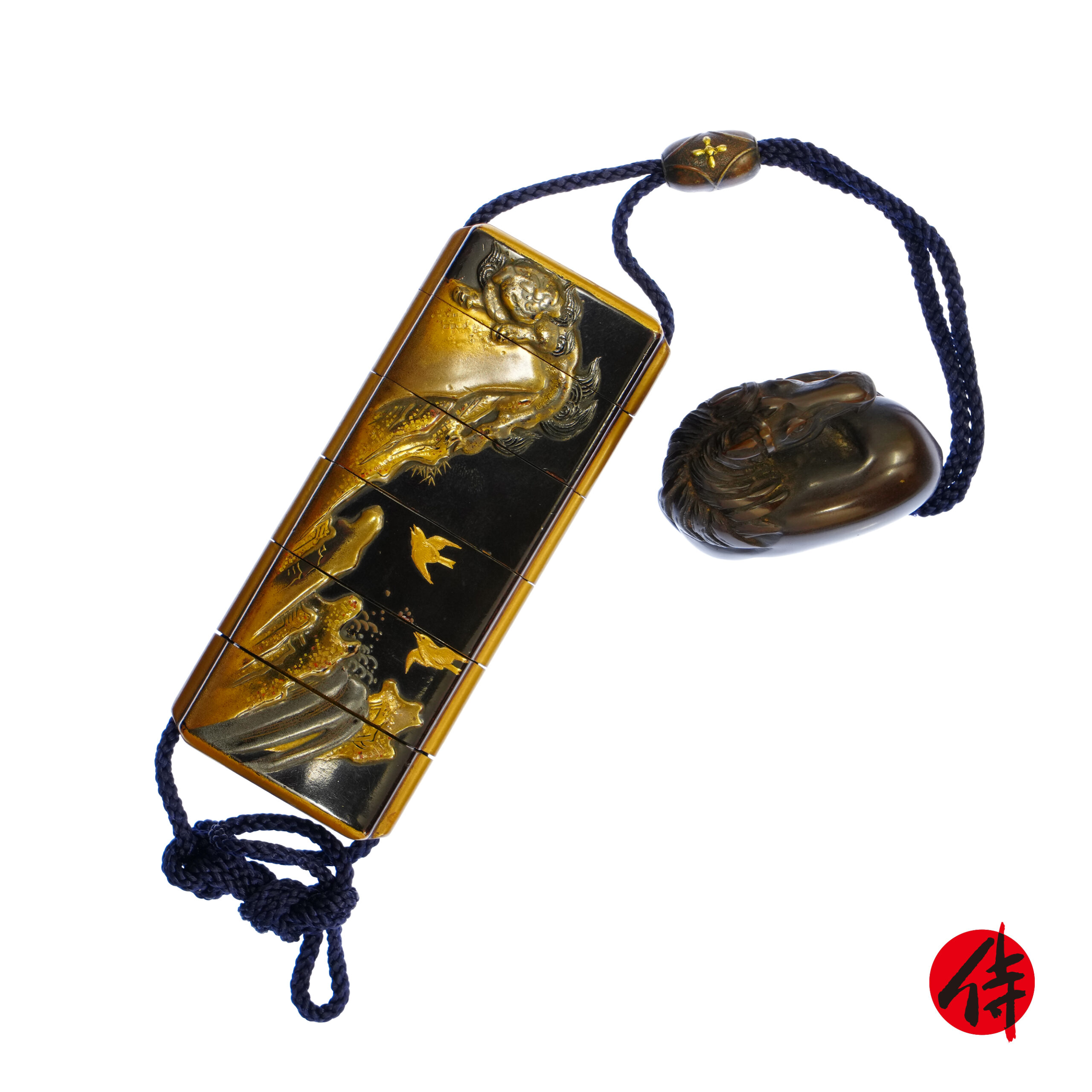
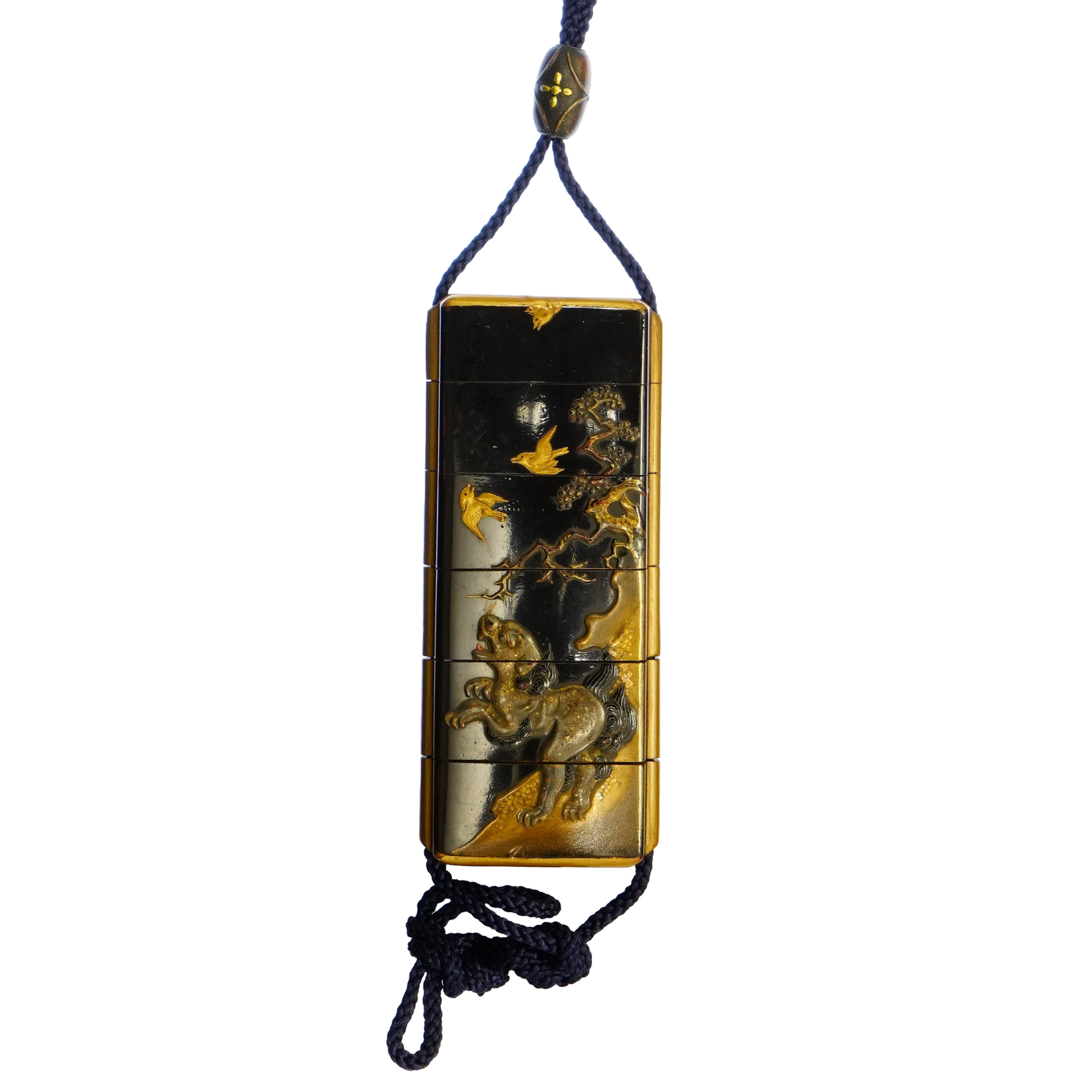
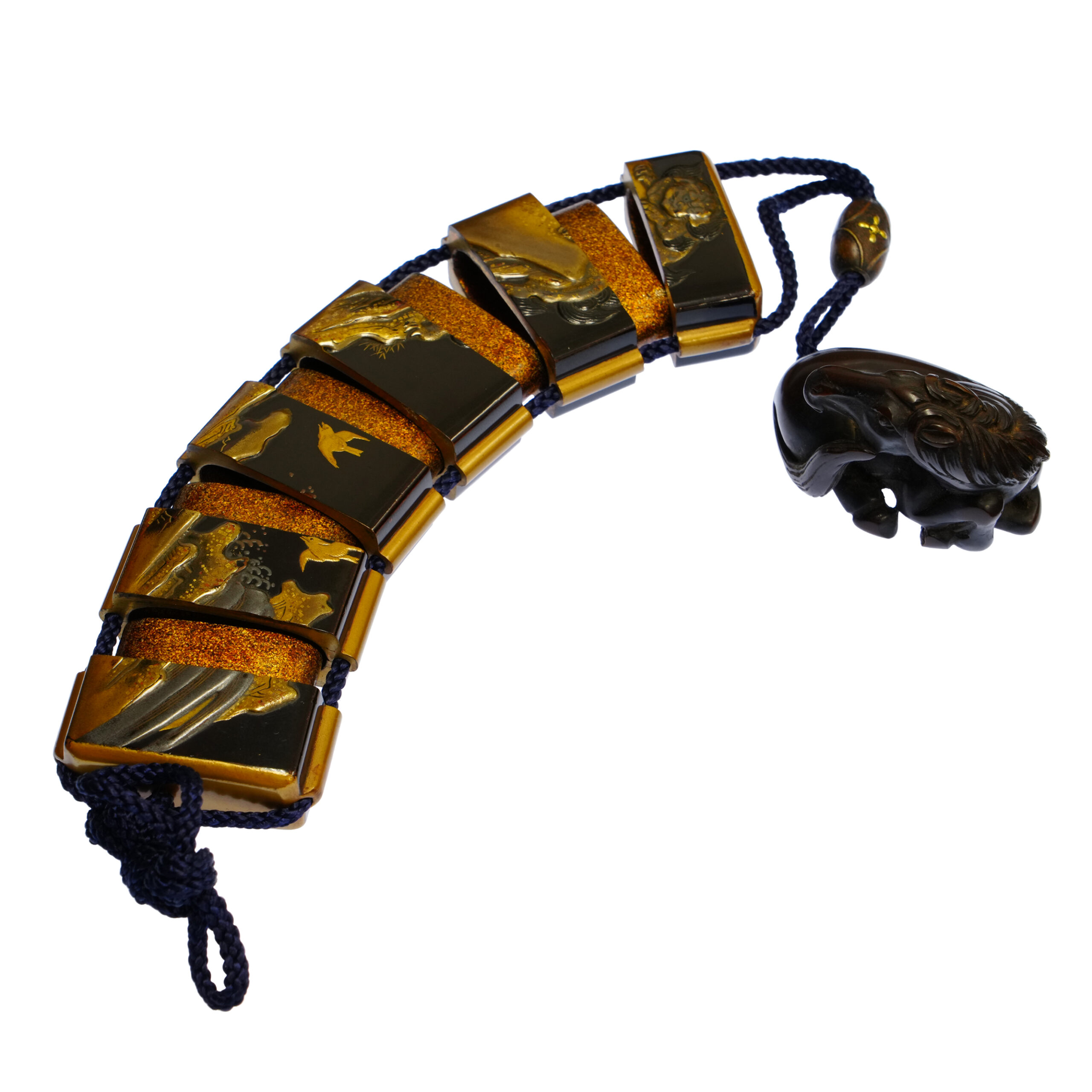
【About us】
Samurai Museum is located in Tokyo, Japan, exhibiting antique artifacts related to the Samurai history. Samurai Museum Shop is the place for those who are interested in Japanese culture and craftsmanship. We deal with antique Samurai swords/armor, traditional crafts made in Japan and so on.
【Payment method】
We accept payment through Stripe (Credit card), PayPal, Apple Pay or ChromePay, all of which are secure payment methods. Also, you don’t need to make an account on Stripe for the checkout. If you prefer other payment method, please contact us. You may either pay in JPY, USD, AUD, CAD, EUR, CHF or GBP. The price is set in Japanese Yen. Prices in other currencies are automatically calculated based on the latest exchange rate.

【Shipping duration】
We normally ship via EMS (Express Mail Service) provided by Japan Post. It usually takes at least 5-14 days to deliver the package after you place an order.
We offer Free International Shipping as long as we can ship your order by EMS. If you prefer other shipping carriers, please contact us.
We will inform you of the order’s tracking number via email. Please make sure you fill out your valid email address correctly.
*If you like to make sure if EMS shipping is available to your country, please contact us.

【Antique Japanese item and Export process】
After receiving the full payment from you, we will apply for its export permit from the Board of Education to legally export the item to other countries. It normally takes around 2 to 4 weeks to receive this permit. And we would like you to expect at least 1.0 – 1.5 months for your order to arrive at your given address after you ordered.
【How to make sure the condition】
Please keep in mind that what you are going to purchase is an antique item. We uploaded high resolution photos for you to check its condition thoroughly. If you like to see more photos with different angles, please feel free to contact us. We will be happy to send them to you so that you can make informed decision.
It is essential for us to know that you are happy with your choice of antique item and we are prepared to use the best of our ability to serve you.
Would you like see some more Antique items for sale? Please check the link below. We hope you can find your favorite item.
https://www.samuraimuseum.jp/shop/product-category/antique/
